Japanese Religion Through the Lens of Water
By Catherine Ludvik
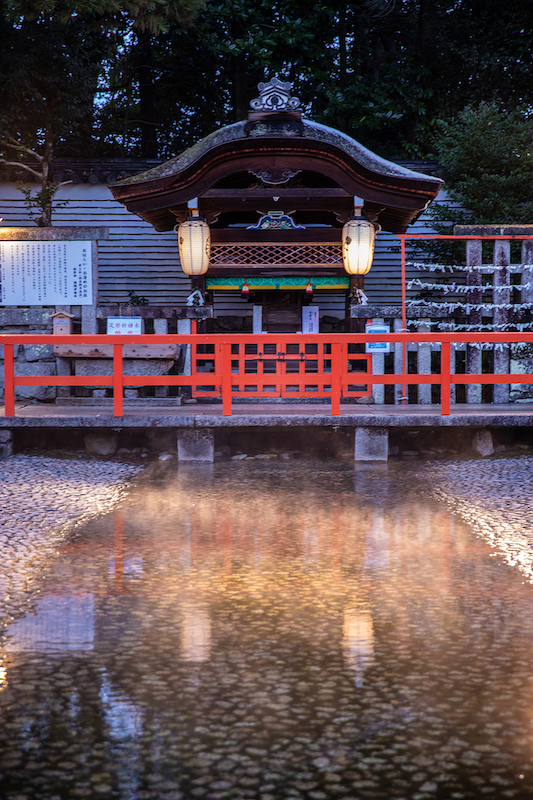
As water is essential to all life, both its presence and its absence, its sufficiency, its excess, as well as its paucity, have fundamentally affected, profoundly influenced, and indeed guided the lives of Kyoto people in countless ways. While the need for water is universal, the quantity, quality, and type of water found in different places varies considerably and therefore impacts significantly the lifestyles, the ways of thinking and perceiving, the belief systems, and the artistic creativity of different peoples. In this article, I address Japanese religion through the lens of water within the context of Kyoto’s geography of surrounding mountains, waterfalls, and rivers, its long history, and its especially high concentration of shrines, temples, and tucked-away religious sites.
My decades-long research on the Indian river goddess Sarasvatī and her transmission across Asia to Japan, as Benzaiten, has heightened my own awareness of water and fluidity, concrete as well as referenced and symbolized, and guided my interpretations and understandings of what I encounter. When I teach Japanese culture, inevitably I include a class on the wide-ranging topic of water-related culture, and given my own particular interests in religion, one of the big questions is always the relationship of water to Japanese religion. This is a vast and profound topic, which I will merely introduce here, through a selection of themes related to Shinto, Japanese Buddhism, and Shugendō mountain asceticism.
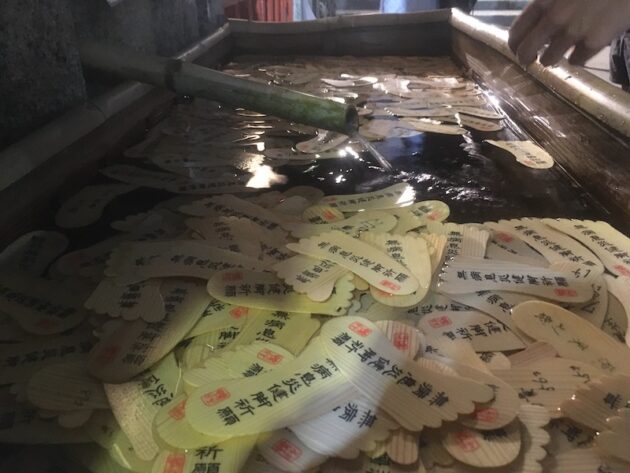
In religion, water and its invocation take a twofold form: concrete and symbolic. Concretely, water is an absolutely essential element of our lives in this world, without which our day-to-day existence would grind to a halt and our physical bodies, made up of about 60% water, would cease to exist. Water, therefore, is an object of invocation, in rainmaking prayers for example, through the medium of water-related gods and goddesses. As a treasured commodity, it also takes the form of a devoted offering, be it to kami, buddhas, or ancestral spirits. As a life-giving, energizing force, moreover, it is endowed with powers of not only physical cleansing, but also spiritual purification, healing, and transformation. Thus water is used in ascetic practices, religious ceremonies, as well as in divination.
Purification and Prayer
Purification by way of water can be found in numerous religions, including Shinto and Japanese Buddhism. Upon entering Shinto shrines and as well as many Buddhist temples, visitors customarily purify themselves by washing their hands with water at temizuya purification fonts. The physical gesture of ablution cleans the body and symbolically cleanses the heart, removing accumulated misfortune, misdeeds (tsumi) and defilement (kegare). Both body and mind/heart are thereby prepared for worship of the kami and buddhas, whose sacredness and venerability is expressed likewise through the preparatory purification act.

Private prayers, rituals performed by priests, and festival ceremonies all involve purification of the clergy and participants in different forms, most commonly involving water. During the month of May in the Aoi Matsuri festival at Kamigamo, Shimogamo and Mikage Shrines of Kyoto, for example, not only do the Saiōdai imperial princess and her attendants purify themselves at the streams of Kamigamo or Shimogamo Jinja (Misogi no gi on May 4th), the riders of the horses dip their tabi and riding sticks in the sacred Kamigamo stream, and even the horses are purified by pouring handfuls of water on their legs (Ashizoroe shiki on May 1st). 1
Purification may be the preparatory stage for a ceremony, but it may also be the essence of the festival, as in the Mitarashi Matsuri of Shimogamo Jinja and of Konoshima Jinja (Kaiko no Yashiro) in late July, where participants wade through the respective shrines’ sacred ponds, at Shimogamo Jinja with a candle in hand, in a summer purification prayer to ward away illness. At the far better known Mitarashi Matsuri of Shimogamo Jinja, nowadays people also inscribe their names and ages on foot-print shaped wood talismans, prayers for good health and strong legs, which they place in a font of water.
Ascetic Practice
Purification can also take a more intensive, unabbreviated ascetic mode of misogi, involving the submerging of the entire body in water, be it a tank, a river, the sea, or a waterfall (the practice of takigyō), thought to be especially effective in the winter season. Such full-body ablution practices are widespread throughout Japanese religion, Shinto, Buddhist, and Shugendō, and involve preparatory stages, including prayers, particular garments–white robes or a simply a white loincloth for men—and vigorous recitations accompanied by hand gestures during the practice itself. Numerous sites for such practices in and around Kyoto included Kiyomizudera’s famous Otowa Waterfall (formerly), several smaller waterfalls at Fushimiyama behind Fushimi Inari Taisha, the Okunoin Inner Shrine behind Nanzenji, and Kūya no Taki near Kiyotaki. Especially when performed in cold seasons, these practices are physically demanding and bring on a doubled intensity in the recitations and in one’s concentration, leading to a powerfully impactful experience. Seasoned practitioners are believed to acquire powers, such as abilities to communicate with the spiritual world, to heal, and to exorcise. 2
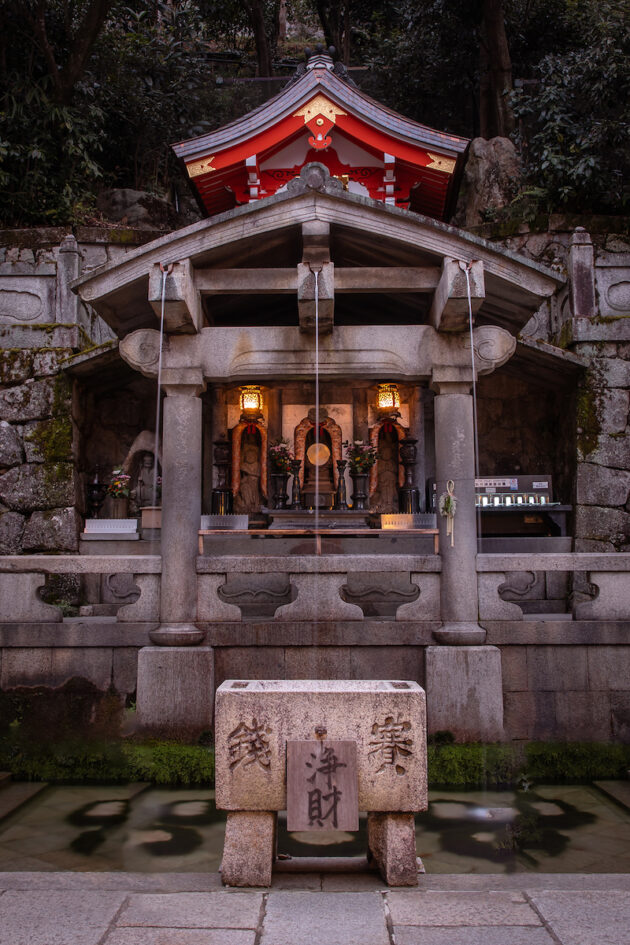
Another particularly ardous form of water austerities that can be witnessed in Kyoto is the suigyō of the Nichiren sect of Buddhism. Priest-practitioners who have undergone the 100-day Great Severe Ascetic Practices (dai aragyō) of the winter season come to some of the Nichiren-sect temples of the city, such as Matsugasaki Daikokuten, and in the intense cold of February, wearing mere loincloths, douse themselves repeatedly with bucket-fulls of cold water amidst powerful recitations. Amazingly, the practitioners have engaged in this severe form of purification seven times daily throughout their 100-day ordeal!
Hot Water: Performance, Divination, and Healing
While most purifications and water practices involve cold water, some use hot or even boiling water. The yudate kagura is a boiling water ritual that has many forms and a diversity of practitioners. 3 Shrine maidens (miko) perform it as a kami ritual for purification and to divine the will of the kami. Shugendō ascetics may conduct it prior to entry into the mountains for spiritual practice, or as a display of power when the practitioner pours the boiling water from the cauldron over himself. As a kagura performance, the ritual can also take the form of a dance around the cauldron. In Kyoto, yudate kagura can be witnessed at Jōnangū and Iwashimizu Hachimangū shrines, for example, performed by senior shrine maidens. Sacred water is boiled in a large, steaming cauldron, to which may be added sake, rice, and salt. The performer invokes kami and spirits to descend, offers them water, and makes prayer petitions. The boiling water is then stirred with bamboo branches and dramatically sprayed around over the surrounding attendees, who are thereby purified and blessed.
Yudate kagura in its origins is closely connected to Kumano beliefs and its local onsen hotsprings. Due to their healing properties, moreover, onsen commonly have founding legends and Onsenji temples as well as Onsen Jinja shrines, such as at the famous Arima and Kinosaki Onsen in Hyogo Prefecture. The hot mineral waters are also often given the names of buddhas or other deities, like the numerous Yakushi no yu, after the Buddha of Healing Yakushi, found throughout the country. Furthermore, Japan has a history of devotional bathing practices, including the nenbutsu bathing ritual, religious confraternity bathing, and baths sponsored for memorial and meritorious purposes.4
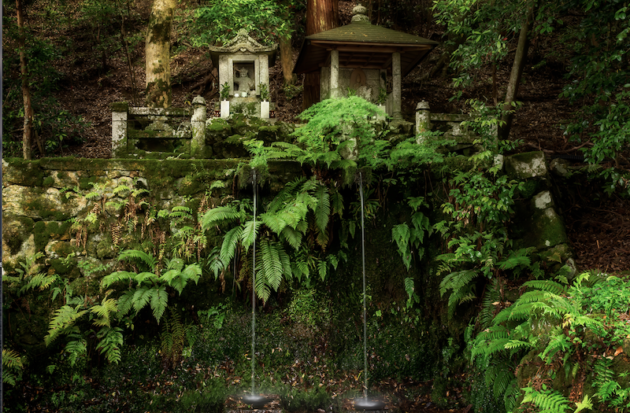
In addition to yudate kagura, another form of divination using water, in this case cold water, is the non-performative, private mizu ura mikuji, in which one’s fortune appears on the omikuji slip when it is placed on water. While Kifune Jinja, deeply connected with water through its kami and its history of rainmaking prayers, is perhaps best known for this kind of omikuji water divination, it is also found at several Kyoto shrines, including Shimogamo Jinja during the Mitarashi Matsuri, Kitano Tenmangū, and Nashinoki Jinja.
Rainmaking and Dragons
Universally, especially in agricultural societies, rain has always been vital to the food supply and to survival itself. Since ancient times, when there was drought, communities in Japan would gather and perform amagoi rainmaking practices in a variety of forms, invoking water-related deities. Petitionary prayers might be accompanied by seclusion at a shrine, offerings, rain dances, ritual ceremonies, as well as cohercive methods to induce rain. Local rites of the populace coexisted alongside larger scale court-sponsored rainmaking practices, including also the offering of horses, as recorded in the Shoku Nihongi. In the 9th century, the Kamo, Matsuno’o, and Kifune Shrines in and around Kyoto were among the shrines receiving the most rainmaking offerings in Japan. By the mid-Heian period, black horses were offered to Kifune Shrine for rainmaking and white ones for rain-halting.
The association of dragons and snakes with water, and specifically with rainmaking and rain-halting in order to end flooding, is found throughout Asia, from the nāga serpent-deities of India to the Chinese and Japanese dragons. Elaborate Buddhist ceremonies were developed in India from after the 4th century, rainmaking texts were then translated into Chinese, and Buddhist rainmaking ceremonies were performed in China as well, most notably by patriarchs of the esoteric Shingon sect, Amoghavajra (705¬–774) and Huiguo (746–805). The texts and rituals were brought to Japan, where Shingon priests became expert rainmaking ritualists par excellence, claiming access to the most powerful dragon king of all, Zennyo (Nāgarāja Anavatapta), who was said to reside in the pond of Kyoto’s Shinsen’en imperial garden. The pond itself was also identified as Lake Anavatapta, a lake located at the top of the world in Buddhist cosmology. Today, Shinsen’en is a fraction of its original size, as is its pond, but the dragon king continues to be worshipped there. 5
Dragons are also commonly painted on the ceilings of temple halls and even of temple gates, often but not exclusively at Zen temples. In Daitokuji’s Sanmon gate, for example, the illustrious painter Hasegawa Tōhaku has depicted dragons on the ceiling. Numerous interpretations of the significance of dragons in this context—a vast and profound subject all unto itself—include prayers for fire prevention, an unfortunately far too common hazard of wood construction, through the invocation of these powerful beings who govern water and protect the temple.
Water Gods and Goddesses
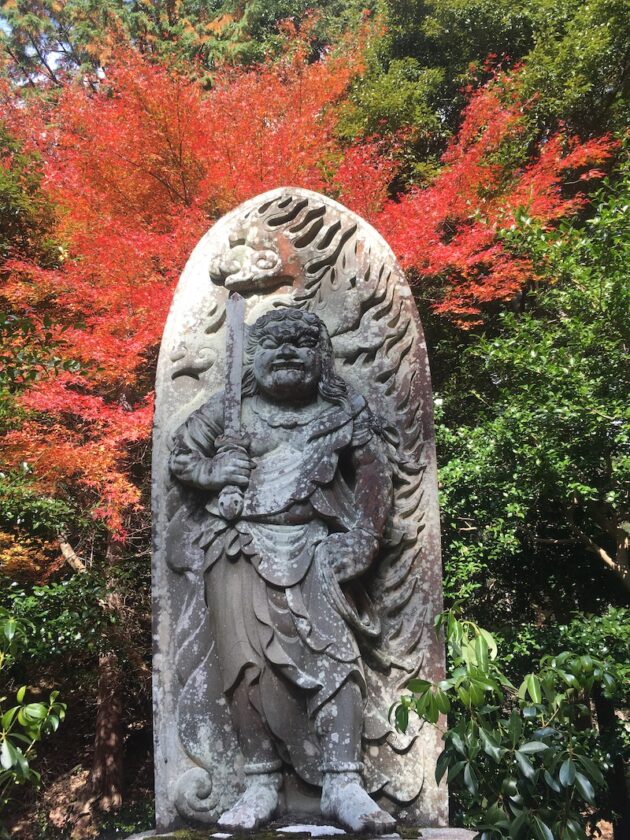
Besides dragons, a variety of water-related gods are worshipped in Kyoto, and indeed throughout Japan. Among the kami are Suijin tutelary deities of water, the water-distributing Mikumari, Kifune Jinja’s Takaokami, the child of Izanagi who governs water, and the sea goddess Ichikishimahime. Buddhist deities include the water celestial Suiten (Varuṇa), the goddess Benzaiten (Sarasvatī), and numerous nāga as dragon and serpent deities. The connection of Benzaiten with water is underlined not only through her worship on islands in bodies of water, like on Chikubushima Island on Lake Biwa, but also in her combinatory form as Uga-Benzaiten, wherein the snake-bodied, human-headed deity of native and nāga origins Ugajin appears on her head. Furthermore, Fudō Myōō, who is closely related to fire through the goma fire ceremonies performed before him, is also inextricably connected with water. He is worshipped as Wave-breaking Namikiri Fudō, as at Namikiri Fudōin in northeastern Kyoto, and at innumerable waterfalls all over Japan, commonly invoked in takigyō.
By looking at Japanese religion through the lens of water, the all-pervading presence of water in its countless forms is revealed. Even in its absence, as in rainmaking prayers, dragon paintings, or dry-landscape gardens, it is made present through invocation and symbolic representation. Vital to life itself and endowed with powers of purification, healing, and spiritual transformation, water inspires a remarkable variety of creative means to invoke it, to draw on its life-giving energy, as well as to express gratitude for it.
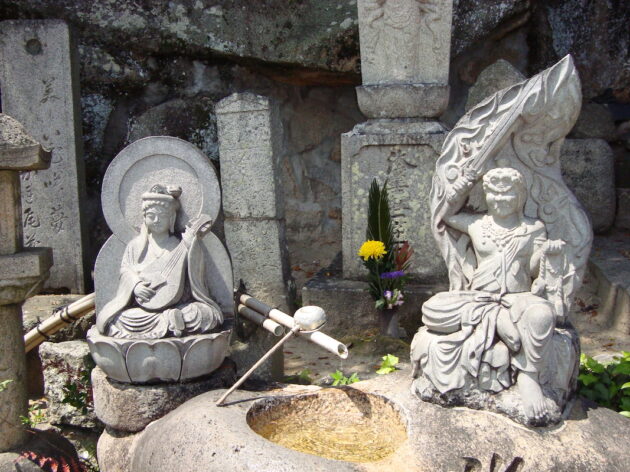
1 On the Kamo shrines and Aoi Matsuri, see John Nelson, Enduring Identities: The Guise of Shinto in Contemporary Japan (Honolulu: University of Hawai’i Press, 2000).
2 On ascetic practices, see Tullio Federico Lobetti, Ascetic Practices in Japanese Religion (Abingdon : Routledge, 2014).
3 See Suzuki Masataka, “Kumano Beliefs and Yudate Kagura Performance,” English translation by Gaynor Sekimori, Cahiers d’Extrême-Asie 18 (2009), pp. 195-222.
4 See Lee Butler, “Washing off the Dust: Baths and Bathing in Late Medieval Japan,” Monumenta Nipponica 60:1 (2005), pp. 1-41.
5 On rainmaking and Nāgas and dragons in Asia, see Alvin P. Cohen, “Coersing the Rain Deities in Ancient China,” History of Religions 17:3-4 (1978), pp. 244–265; Robert DeCaroli, “Snakes and Gutters: Nāga Imagery, Water Management, and Buddhist Rainmaking Rituals in Early South Asia,” Archives of Asian Art 69:1 (2019), pp.1–19; Brian O. Ruppert, “Buddhist Rainmaking in Early Japan: The Dragon King and the Ritual Careers of Esoteric Monks,” History of Religions 42:2 (2002), pp. 143–174; Shimazu Norifumi, “Kiu, shiu” in Kokugakuin University Digital Museum: https://dmuseum.kokugakuin.ac.jp/eos/detail/?id=8576 ; Marinus Willem de Visser, The Dragon in China and Japan (Amsterdam: Johannes Müller, 1913); Jean Philippe Vogel, Indian Serpent-lore or the Nāgas in Hindu Legend and Art (London: Arthur Probsthain, 1926).
CATHERINE LUDVIK obtained a Ph.D. at the University of Toronto and teaches Japanese religion, visual arts, and culture at the Stanford Program in Kyoto, Doshisha University, and Kyoto Sangyo University. Spanning Indian and Japanese religions and their visual arts, her research interests focus on the metamorphoses of the originally Indian goddess Sarasvatī/Benzaiten in the texts, images and rituals of Japan (see ‘Metamorphoses of a Goddess,’ KJ 62), as well as on the circumambulating practice (sennichi kaihōgyō) of the monks of Mt. Hiei and the Shikoku Henro pilgrimage (see ‘Journeys of Reverence,’ KJ 88 – Devotion). ‘Japanese Religion Through the Lens of Water’ is a key article in KJ 101, Water in Kyoto.



